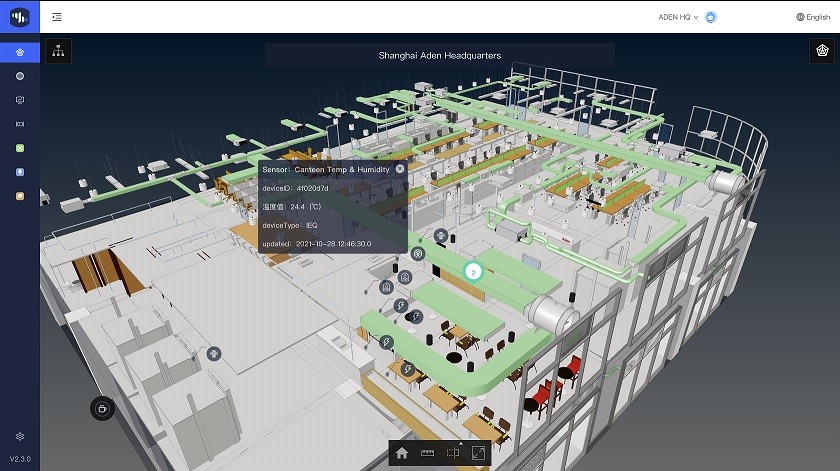It’s the age of experience—UX for web and mobile users, CX for customer experience…now here comes WX—workplace experience. Let’s take a look at how this holistic and employee-centric approach is reshaping facility management and adding value to companies that make wellness and comfort a priority.
Workplace experience (WX) is a way of describing the complex web of business and cultural outcomes that result when companies take a holistic approach to the management of the built environment. Great WX comes when businesses invest in spaces where the physical facility, its environment and digital infrastructure are linked and optimized to work as a single-engine for greater comfort, collaboration, wellness and overall productivity for employees.
What contributes to workplace experience?
WX is a holistic system, starting from what the facility management industry traditionally calls “soft services”. But WX is fed by many other areas, all components of a typical workplace.
- Soft services: food, hygiene & cleaning, front desk, security.
- Hard services & environmental services: energy management, indoor air quality, asset maintenance, waste management.
- Workspace design: floor layout and furniture, greenery, interior design, acoustics, lighting.
- Community engagement: events, collaborative spaces, PD & training, fitness & health programs, service apps, feedback apps, etc.
And on top of all these:
- Digital infrastructure: any and all systems inside the building collecting data from occupancy to energy consumption to AQI.
Data informs better workplace decisions
Another important element of workplace experience is data transparency and data communication. In other words, how well is your workplace standardizing and centralizing its data (often referred to as a single source of truth), and how well is your organization organizing and conveying this information once it has been collected?
What does this mean in practical terms? Imagine, for example, a worksite that has reduced its energy consumption, increased its recycling rate, or achieved a measurably better level of indoor air quality. Any of these by themselves can be counted as wins, but to make the optimal contribution to workplace experience, the company needs not only to quantify this achievement but also make it visible and well-known among employees. This is an area where the digital twin is quickly emerging as a high-value asset.

Simply put, perception counts and transparency pays – nearly 70% of Millennials say that corporate sustainability is a key concern and factor in whether they would stay with an employer, but phenomena like greenwashing have caused optimism about climate action to decrease. By committing to measurable sustainability plus transparency, companies can enjoy a free boost to their buildings’ WX.
The new workplaces must compete on environment, comfort and human-centricity
Greater focus and investment in WX is a trend that will only intensify as Gen Z and Millennials become an overwhelming majority of the workforce. It is also a trend that has picked up with the rise of co-working spaces that compete hard on their strengths: comfort, “coolness,” and flexibility. After COVID-19, a large percentage of the workforce returned to their old offices asking new questions, including: “if we were able to carry on work from the comfort of our homes during COVID, why shouldn’t we continue doing the same now?”
So, in the aftermath of COVID and other long-term shifts in the workforce, will the office simply disappear? Actually, it doesn’t seem that companies or employees want to eliminate the office altogether. Rather, it seems both sides are reassessing how they use the workspace and what they would like to take away from time spent there.
It is notable that while over half of employees report wanting more flexibility around work location increased collaboration and socialization are the #1 reasons employees are looking forward to a return to the office. The difference is, as work culture evolves, talented employees are “voting with their feet”, choosing workplaces that deliver better experiences, flexibility sustainability, and environment. In a recent survey by McKinsey, 4 out of 10 respondents said that they would set workplace experience as a high priority in deciding whether or not to seek new employment.
Meanwhile, companies that have gone through the COVID crisis now have direct experience managing a large share of their workforce remotely. Moving out of the peak teleworking phase, certain questions emerge: do our offices need such a large physical footprint? Are there are ways to reallocate our facilities to accommodate new functions and mixed-use spaces that are open to all and encourage cross-team interaction?
However these modifications are delivered, one thing is clear when workplaces invest in a better environment, it’s not just morale that improves – there are measurable productivity gains. The World Green Building Council, for example, studied how user-centric building design can impact productivity. Among their findings were these productivity boosts:
- +23% productivity from better lighting.
- +18% productivity from regular access to a natural environment.
- +11% productivity from improved ventilation.
Good workplace experience grows from three pillars
The best WX strategy takes a holistic approach and needs to be built on a comprehensive infrastructure with three interconnected pillars: spatial/environmental, digital, and human experience.

Spatial/Environmental:
This pillar is about optimizing use and layout for the physical site, taking into account factors like floorspace and floorplan, ceiling heights and patterns of movement throughout the facility. But this pillar also factors in more subtle but highly impactful environmental categories like light, acoustics, ventilation and smell, as well as the overall tone and identity that your space sets via greenery, interior design and on-site amenities. One of the key measures here is your space’s flexibility, with the long-term trend moving strongly away from departmental silos towards shared, mixed-use spaces which can easily transition between work, training and social functions.

Digital:
Best practice for this pillar is an integrated approach:
- Mobile-based tools – used by employees for everything from ordering food to making room reservations to reporting maintenance needs. Used by solution providers for task management and KPI tracking.
- IoT sensors measure everything in real-time from space occupancy to air quality to on-site safety.
- A digital platform that links, optimizes and visualizes the resultant data in a way that empowers better decision-making and cost savings.
While this pillar is necessarily complex, its key objectives can be summarized in fairly simple terms. One, it makes the experience of being at work more convenient and responsive to the needs of building users. Two, it gives companies and building managers much richer situational awareness of what actually happens in their buildings, from how effectively services are being delivered to preferences and patterns of behavior that employees show while at work. From this deepened understanding comes faster and better decision-making about how to optimize the workspace.
Human Experience:
While coming last on this list, human experience is necessarily both the main measurement unit of WX and its start and endpoint. This must be measured at several levels – how well does the space enhance individual employees’ ability to work productively? But also, how well does the design, flexibility and overall management of the facility orient different departments towards more interaction and a greater sense of community and purpose?
Optimizing workplace experience is a cycle, not a one-time fix
Some decisions made in a WX project will be fairly obvious at the outset. Maybe employees have been dissatisfied with workspace dining options for a long time – so, you upgrade to a higher level of corporate dining solutions; maybe you face reliability issues with your security provider – so, you find a partner that is capable of integrating more smart technologies into their security solutions.
This class of fixes (such as poor lighting, inefficient air-conditioning, leaky ceilings, and outdated décor) represents surface-level bad WX, the “low-hanging fruit” that is easily identifiable through daily working experience. Without question, addressing these issues quickly and thoroughly is a clear value-add for the morale and productivity of building users.
But great WX comes when companies and facility managers harmonize the three pillars so that each reinforces the next in a cycle of optimization. The idea is to balance direct feedback from building users with rich data from IoT and other digital tools to reveal deeper insights into how your facility and your people are interacting.
Stage 1 – Human experience level:
Start by listening to your people. How do they feel about the workspace? What are their pain points? What would they change? What do they prize most about the space? Start with these questions and continually track reactions as you unroll your WX changes in the next steps.
Stage 2 – Physical/environmental level:
Assessing the feedback from phase 1, determine what can/should be changed about the physical space and environment. Make the changes, getting buy-in from building users by communicating clearly about your intention to create better WX and responsivity.
Stage 3 – Digital level:
As much as possible, install systems and technologies to measure the impact of your changes over time. Do the IoT sensors for occupancy indicate that people are changing their behavior, gravitating towards the upgraded space? If you’ve upgraded your food service, does the data show changes in purchase patterns?
Stage 4 – Human experience level:
Now, assess the impact of change – balance the quantitative data from your sensors and other internal data with the qualitative data of feedback from employees and team leaders.
Stage 5 – Adapt, test, adapt, test:
Utilize the same practices perfected by UX specialists and web developers. One of the main reasons top apps and websites generate such high traffic and conversion rates is that they are regularly optimized based on data from A/B testing and analytics that show user behavior. This same approach can and should be adapted for better WX and business outcomes in the long term.
Stronger together: IFM partners are your best workplace experience asset
As should be clear from the article above, the best WX outcomes result from a complex interplay of teams, systems, and digital and physical infrastructure. This complexity is one reason why an integrated facility management (IFM) partner brings distinct benefits to a WX project.
First, there is a question of definitions– what do we mean by IFM vs. traditional FM? Let’s start by looking at the traditional models:
- Single service: One company provides one type of service at your facility. For instance, food service. This team may be excellent, but it functionally operates in a silo of its own.
- Multi-service: One company provides several teams at your facility, but they are managed separately, pursuing their own KPIs.
Then, we have integrated facility management
- IFM: Several teams are managed by a single provider, with a central point of contact and management for all of these teams. This might be a combined food, maintenance, security and hygiene contract in one workplace, or it might be a series of teams spread across multiple client sites (and even borders for multinational clients)
In IFM, the focus shifts from simple service delivery to a partnership model in which the IFM provider helps the client pursue goals at the macro level. By adding a level of control above classic service teams, IFM providers are able to coordinate across services, pursuing macro goals that support better WX and finding efficiencies through careful, data-driven analysis of worksite performance.
